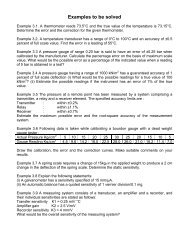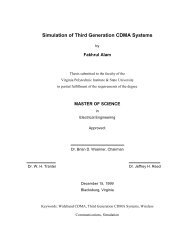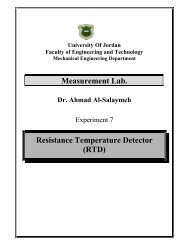Communications I Dr. Mohammed Hawa Introduction to Digital - FET
Communications I Dr. Mohammed Hawa Introduction to Digital - FET
Communications I Dr. Mohammed Hawa Introduction to Digital - FET
Create successful ePaper yourself
Turn your PDF publications into a flip-book with our unique Google optimized e-Paper software.
You also recall that using a RZ rectangular pulse instead of a NRZ rectangular pulseresulted in expanding the bandwidth by a fac<strong>to</strong>r of 2. This is an immediate result ofthe “Time compression, Frequency expansion” property of the Fourier transform,and is also illustrated in Figure 27.The question that arises now is this: If we pick a data stream encoded using aparticular line code (say polar encoding), can we control its bandwidth by changingthe pulse shape p(t) while still keeping the polar line code rule? The answer <strong>to</strong> thisquestion is YES; picking the right pulse shape can result in smaller bandwidthcompared <strong>to</strong> the bandwidth of the rectangular pulse which is, strictly-speaking,infinity (because the sinc() function extends from minus infinity <strong>to</strong> positive infinity).If we choose a smoother pulse (compared <strong>to</strong> the rectangular pulse), the highfrequencies in the resulting PSD of the data stream are eliminated. For example, ifwe pick a triangular pulse instead of a rectangular pulse (see Figure 27) the highfrequency components are heavily reduced. (This is more apparent if you look at thespectrum using a log scale). Remember that the Fourier transform of a triangularpulse is sinc 2 () and, hence, the PSD has the shape of sinc 4 () function.Reducing high frequency components in the PSD is important so that the signal canpass through band-limited channels without <strong>to</strong>o much linear dis<strong>to</strong>rtion. Suchdis<strong>to</strong>rtion usually creates what is called inter-symbol interference (ISI) in digitalsystems, where one bit value overlaps with (and corrupts) the adjacent bits.Using smoother pulses (and hence reducing their high frequency content) can betaken <strong>to</strong> the extreme if we pick a pulse that is not limited in time. In other words, thepulse spells outside the bit time (T0). This will limit its Fourier transform (because anexpansion in the time-domain results in compression in the frequency-domain).One popular example used in many practical systems is the raised-cosine pulse. This isa pulse that looks similar <strong>to</strong> (but decays much quicker than) a sinc(t) function and has aFourier transform similar <strong>to</strong> a raised cosine shape in the frequency domain. Thispulse and its corresponding Fourier transform are shown below. The raised-cosinepulse shape changes with a parameter called the roll-off fac<strong>to</strong>r . The Figure belowshows a = 0.5 raised-cosine pulse with the corresponding Fourier transform.1 Vp(t) = Raised Cosine PulseP(w)T 0 f 0/2-3T 0-2T 0-T 00T 02T 03T 0tw- 2pf 0 - pf 0 0pf 0 2pf 0f- f 0 - f 0/2 0 f 0/2f 0This type of pulse satisfies what is called the first Nyquist ISI criterion, which statesthat it is OK for the pulse shape not <strong>to</strong> be limited <strong>to</strong> the bit time (T0), so long as itdoes not introduce inter-symbol interference (ISI) in the transmitted pulse stream.18
















